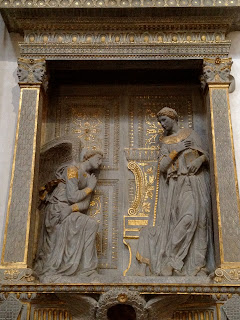Ambrogio Lorenzetti
During the later dugento, and in the early trecento,
humanism was a concept that artists were starting to experiment with. Instead of Christ the judge, a lot of artists
portrayed the life of Christ through the Virgin Mary. Mary became a symbol, since she was an
intercessor that helped humans feel closer, and more at ease when communicating
with God.
Besides
humanism, painters were also beginning to become more naturalistic as
well. Some painters like Giotto, and
Martini were in this category of more naturalistic. These naturalistic painters painted
everything in a more natural way, and more realistic portrayals than the
Byzantine style of art. Among these
painters, I found that during the trecento there was a painter whose style was
said to “anticipate the renaissance”.
Ambrogio Lorenzetti, brother of Pietro Lorenzetti, was influenced by works
of Martini, but even more so naturalistic.
While at the Uffizi, an altarpiece caught my eye, and I started to
research it. This altar piece is a
triptych style altarpiece by Ambrogio, in 1332.
This altarpiece in three pieces is entitled Madonna and Child with Saints Nicholas, and Proculus which was
painted for the Florentine church in San Procolo. This painting is a tempra on a panel, and is
interesting because the baby Christ is holding onto Mary’s finger in a loving
way, which is more natural to the relationship between a mother and child. On the right and left of her, are the two
saints, and located above (as to my knowledge) are Christ the redeemer, John
the Baptist, and John the Evangelist.

Madonna and Child with Saints Nicholas and Proculus 1332
Ambrogio Lorenzetti (1290-June 9, 1348)
Wiki Commons
Vasari on Giotto
In the year of 1266, an artist that Vasari, and many others consider to be the father of the renaissance, was born. This artist, Giotto was born to a humble tiller, and he was blessed with the talent of drawing. Even so, that Vasari tells us a story of how as a child, Giotto was noticed by the artist Cimabue. According to this story, Giotto asked his father
to study under this artist, in which his father "lovingly gave consent" understanding the opportunity his son had just been given.
As a better trained artist, what made Giotto so interesting in Vasari's eyes is that he was an "excellent imitator of nature." Meaning Giotto had a this knack for creating this modern art that was more natural, and different than even his teacher. This style he had done was greatly recognized by many others including his friend Dante.
I was intrigued when I finally witnessed Giotto's altarpiece of Madonna and Child Enthroned Among Angels and Saints. In my opinion, this tempera painting on a panel finished around 1310, goes far beyond a similar altarpiece done by Cimabue some twenty years before, and I understand Vasari's interest Giotto's life. Differences I noticed include the more realistic features of the inhabitants of the painting, before people really studied the anatomy of the human body. I also notice that the saints, and angels are gazing up at the Virgin Mary, in awe. It gives evidence about the way that the people of this age felt about Mary, they worshiped her life, and prayed to her rather than Christ the Judge. After studying a few pieces done by Giotto, I agree with Vasari when he explains that Giotto was the father of renaissance (painting).
Statue of Giotto (1845)
Giovanni Dupre
Wiki Commons






















